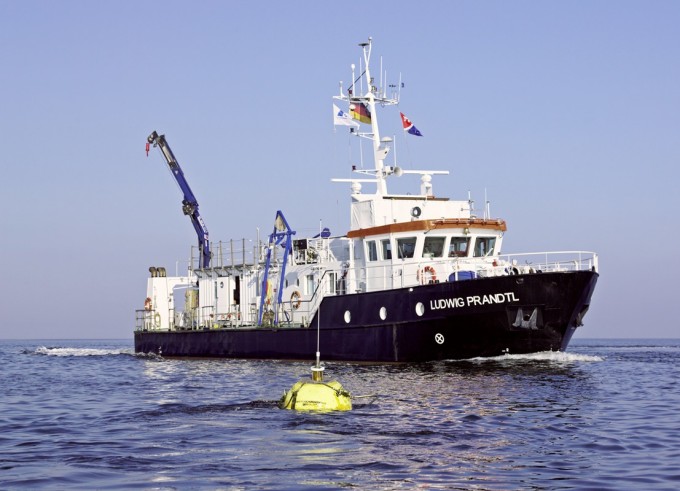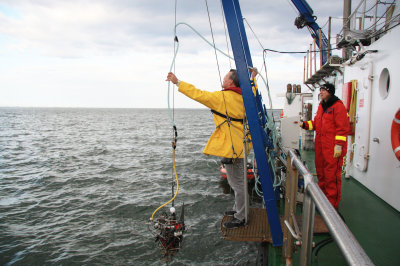Experience coastal research first-hand
On the 12th and 13th of May there will be an Open Ship on the ‘Ludwig Prandtl’ - the research vessel of the Helmholtz-Zentrum Geesthacht. Visitors to the HAFENGEBURTSTAG HAMBURG can go on board and gain first-hand experience of current coastal research developments. Together with the Hamburg Port Authority (HPA), the Institute of Coastal Research at the Helmholtz-Zentrum Geesthacht is presenting its activities under the motto ‘Coastal Protection in Times of Climate Change’.

The research vessel 'Ludwig Prandtl' of the Helmholtz-Zentrum Geesthacht. Photo: HZG/ Christian Schmid
The ‘Ludwig Prandtl’ will be moored in the Brandenburger Harbour near the Cap San Diego throughout the HAFENGEBURTSTAG HAMBURG. The Brandenburger Harbour can be reached via the Überseebrücke.
Open Ship
Saturday 12th May 2 p.m. until 6 p.m.
Sunday 13th May 10 a.m. until 4 p.m.
Visitors to the ship can learn all about coastal research, talk with the scientists and explore the ‘Ludwig Prandtl’ from bow to stern. The captain and crew will be on the bridge, ready to give information and answer questions. Scientists from the Institute of Coastal Research at the Helmholtz-Zentrum Geesthacht and employees of the Hamburg Port Authority (HPA) will jointly present their endeavours in the Elbe and North Sea region under the motto ‘Coastal Protection in Times of Climate Change’.
As Prof. Dr. Hans von Storch, director of the Institute of Coastal Research at the Helmholtz-Zentrum Geesthacht explains: “We regard making our research accessible to the public as an intregal part of our work. Our ‘Ludwig Prandtl’ is an excellent platform to achieve this.”
On board the vessel, visitors can become familiar with various measuring devices or ascertain from the North German Climate Atlas how many summer days are to be expected in Hamburg in 2050, for example. The presentation shows innovative technologies and coastal protection measures under changed climate conditions. Working together with the Hamburg Port Authority, Geesthacht coastal researchers are investigating, for instance, the potential effectiveness of artificial sandbanks in the mouth of the Elbe as a coastal protection measure.
Research on the North Sea Coasts

The research vessel 'Ludwig Prandtl' in the North Sea. Photo: HZG
Various measuring techniques and devices are employed on board the ‘Ludwig Prandtl’ or tried and tested during development. The ‘Ludwig Prandtl’ is also involved in the COSYNA (Coastal Observation System for Northern and Arctic Seas) project.
COSYNA is an analysis system developed by the Institute of Coastal Research at the Helmholtz-Zentrum Geesthacht for the monitoring of the coastal regions of the North Sea. In addition to the measuring devices on the ‘Ludwig Prandtl‘, Geesthacht scientists also utilize radar technology, wave measuring buoys or earth observation satellites.
In March 2012, employees from the Helmholtz-Zentrum Geesthacht and the Hamburg Port Authority installed a measuring pole in the mouth of the Elbe. Since then, this pole has regularly delivered data which is used to examine water quality and sediment transport and to achieve more precise forecasts for the storm surge warning service.
The research vessel ‘Ludwig Prandtl’
The ‘Ludwig Prandtl’ is the research vessel of the Helmholtz-Zentrum Geesthacht. Due to its draught of less than 1.70 metres, it is particularly suitable for research in shallow and tidal waters. The main areas of operation are the waters of the mudflats on the North Sea, the mouths of various rivers and the coasts of the southern Baltic.
With a length of 31 metres the ‘Ludwig Prandtl’ provides space for extensive scientific equipment and is primarily used to take measurements for the monitoring of coastal waters. The ‘Ludwig Prandtl’ is deployed for research purposes from March to November. Between voyages the coastal researchers frequently use the vessel as a platform to present their research topics to the public.
Contact

Helmholtz-Zentrum Geesthacht
Phone: +49 04152 87-1677
E-mail contactMax-Planck-Straße 1
21502 Geesthacht
